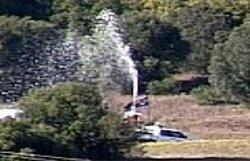The development of the coal seam gas (CSG) industry brings risks to Australia’s limited water resources.
 It draws contaminated water out of the ground, damages aquifers and uses and pollutes large quantities of freshwater.
It draws contaminated water out of the ground, damages aquifers and uses and pollutes large quantities of freshwater.
These risks, and the implications for health, agriculture and the environment are central reasons for the growing community campaign to stop CSG mining.
‘Produced water’
CSG is trapped in coal by water pressure. In order to extract the gas, wells are drilled into the coal seam to pump out the water. The extraction of water releases the confining pressure and allows the gas to be recovered.
This ‘produced water’ is problematic for a number of reasons:
- it is saline and can contain toxic compounds including heavy metals and/or radioactive compounds. Read more.;
- it contains dissolved methane, which can appear as gas bubbles if there is enough dissolved in the water;
- it may contain traces of chemicals that are used for drilling (such as potassium chloride);
- it may contain traces of chemicals used during stimulation techniques such as hydraulic fracturing (‘fracking’), which are used where gas recovery is slow;
- there is growing evidence that methane associated with shale gas extraction in the United States has contaminated drinking water.
Leaks and Blow-outs
Produced water is generally stored in open surface evaporation ponds or tanks near the well-heads, and/or shipped off-site. Poorly managed production water has potential to pollute land and streams around CSG mining operations and to impact on the health of flora and fauna. There is also potential for drilling or fracking fluids to be released into the environment through discharge during drilling or from storage dams or containers.

CSG wellhead blow-out. Camden North, NSW. May 2011
This has happened in Queensland and NSW. On 17 May 2011, a blow out occurred at AGL’s CSG well head at Camden North in NSW during routine maintenance. This incident released plumes of contaminated water and foam into the atmosphere in the vicinity of housing and a water catchment feeder stream. AGL failed to report the incident for two days until the leakage was shown in TV. On June 23 2011, there was a blow out at an Arrow Energy CSG well headnear Dalby in Queensland. Methane and water spewed up to 90 metres in the air for two days before being capped.
Aquifer damage
The Australian Petroleum Production and Exploration Association acknowledge that CSG extraction has potential to deplete or contaminate local aquifers. There are many of these in the northern Illawarra that recharge streams, creeks, lakes and dams in the water catchments and coastal plain.
The National Water Commission estimate that the Australian CSG industry will extract around 7,500 gigalitres (GL) of produced water from ground water systems over the next 25 years. To put this in perspective, that’s more than 13 times the capacity of Sydney Harbour. They also note that the potential impacts of CSG development on water systems, particularly the cumulative effects of multiple projects, are not well understood.